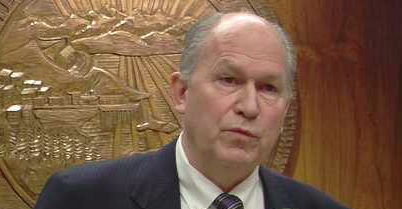
This week, Alaska Gov. Bill Walker declared a statewide disaster.
It’s a flood. No, it’s a fire. Or encroachment by rising tides, or perhaps it’s a wind event and the power is out over a wide swath of land.
Actually, it is a human behavior. An addiction.
Humans in Alaska are putting things in their bodies that don’t belong there. They are intentionally poisoning themselves with heroin and synthetic drugs. And this behavior is widespread enough to be considered, by the Walker Administration, in the realm of natural disaster.
By making opioid addiction a declared disaster, the governor hopes to draw in some federal monies to help with medicine that can prevent overdoses. It’s unclear at this point what federal money might be freed up this way.

Later today the governor will roll out his Overdose Response Program under Alaska’s chief medical officer, Dr. Jay Butler, and this will make available the wide distribution of naloxone, which helps prevent opioid overdose deaths.
“This disaster declaration is an important first step in addressing our public health crisis, which has devastated too many Alaskan families,” Governor Walker said in his statement yesterday. “When earthquakes, fires or floods claim lives and property on a large scale, a declaration of disaster is issued to prioritize the state’s response. This is no different. We must stop this opioid epidemic. My order ensures that our resources are properly allocated to tackle this challenge. However, this is only the first step. It provides a temporary solution; we must work on a long-term fix.”
Today at a 12:30 p.m. news conference, Walker will announce the next steps.
But there are questions already being asked about his first step. Why is self-induced addiction a disaster, when domestic violence and sexual assault in Alaska is not? Alaska’s rape rate is almost three times the national average; for child sexual assault, it’s nearly six times.
According to the governor’s disaster declaration, the number of heroin-associated deaths in Alaska quadrupled from 2009 to 2015, and since 2015 synthetic drug overdose deaths have occurred, although his declaration does not say how many.
“The severity and magnitude of this epidemic make it a condition of public health importance that is beyond the timely and effective response and recovery capability of local resources, and emergency assistance is needed…” Walker wrote. His order allows first responders ready access to naloxone to counteract the effects of overdose.
But what is a public health emergency? According to the New England Journal of Medicine, three years ago Massachusetts Gov. Deval Patrick declared the state’s opioid-addiction epidemic a public health emergency.
“The declaration empowered the Massachusetts public health commissioner to use emergency powers to expand access to naloxone, an opioid antagonist that can reverse overdoses; develop a plan to accelerate the mandatory use of prescription monitoring by physicians and pharmacists; and prohibit the prescribing and dispensing of hydrocodone-only medication (Zohydro, Zogenix), which had been recently approved by the Food and Drug Administration, amid much controversy.1 The governor also allocated $20 million for addiction-treatment services,” the Journal explained.
Today, the opioid epidemic in Massachusetts rages on. And there’s no indication that Gov. Patrick’s tens of millions of dollars has slowed it down one bit.

But the Journal questioned the invocation of a public health emergency, when usually that is reserved for things like infectious diseases, natural disasters, or terrorism.
We have to ask the questions:
- Are car crashes considered public health emergencies? They kill more people than opioids.
- Is diabetes or obesity a similar health emergency?
- When, if ever, should normal lawmaking and enforcement be suspended and a type of executive power be implemented to protect the health of the public?
- When, if ever, will the governor lift the emergency powers? How will he know when the crisis is averted or at least stabilized?
- Is this emergency order similar to the one last year titled: “Hiring freeze and travel ban” that was promptly ignored even by the Governor’s office?
The legal framework for public health emergency powers give the governor great flexibility and power to act in instances, such as an Ebola outbreak, when a more deliberative process could cost lives. Although he is unlikely to need military personnel, the disaster declaration gives him all kinds of authority, including suspending civil liberties and tapping funds — like the Permanent Fund for a example — that would normally be off limits.
“Emergency powers sit largely outside the ordinary structures of checks and balances. Even when time-limited, they’re generally renewable at the governor’s discretion; only some of them can be terminated by the legislature,” the New England Journal of Medicine explains.
“The spirit of emergency-powers laws seems to enshrine three key criteria for suspending normal lawmaking processes: the situation is exigent, the anticipated or potential harm would be calamitous, and the harm cannot be avoided through ordinary procedures. The archetypal scenario is the sudden outbreak of a highly communicable, lethal disease — such as the unlikely event of an Ebola outbreak in a U.S. city — when immediate action is required to avert catastrophe. In such circumstances, acute concern for public health is believed to outweigh substantial trade-offs of values we ordinarily hold dear, including individual autonomy, due process, and democratic lawmaking.”
Governor Walker has a high hill to climb to explain how addiction to opioids has reached the level of a catastrophe when so many other public health problems have not.
Suspending regular democratic governance, rule of law, and the usurping the authority of the Legislature is a signal that either the drug addiction problem is worse than we thought, or the governor needs a fix to boost his flagging public image.